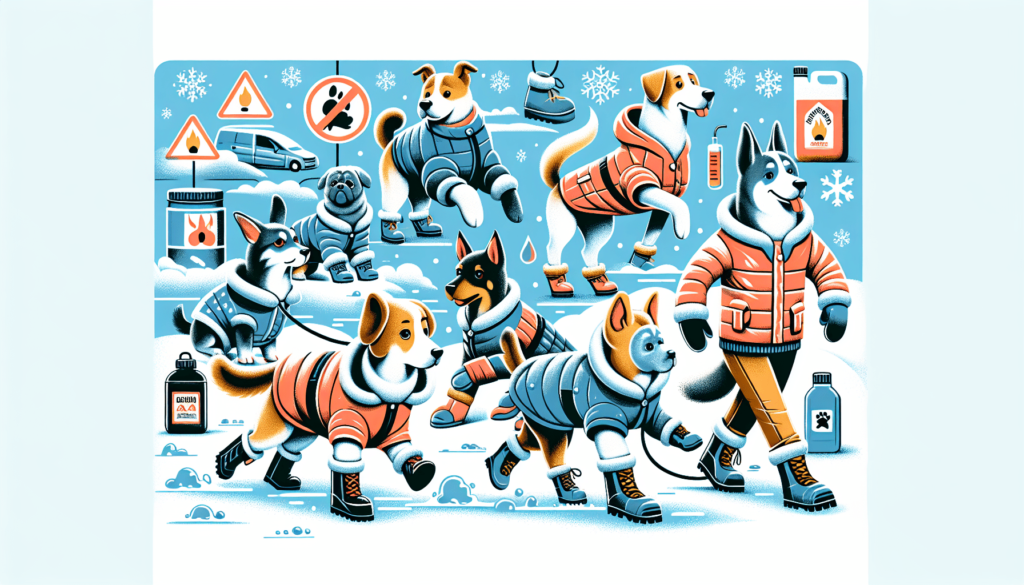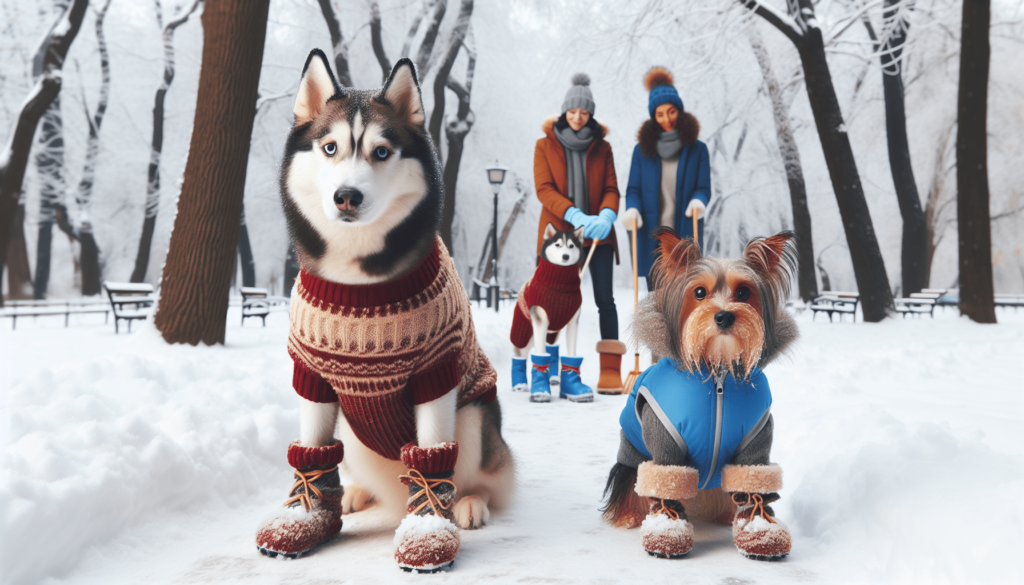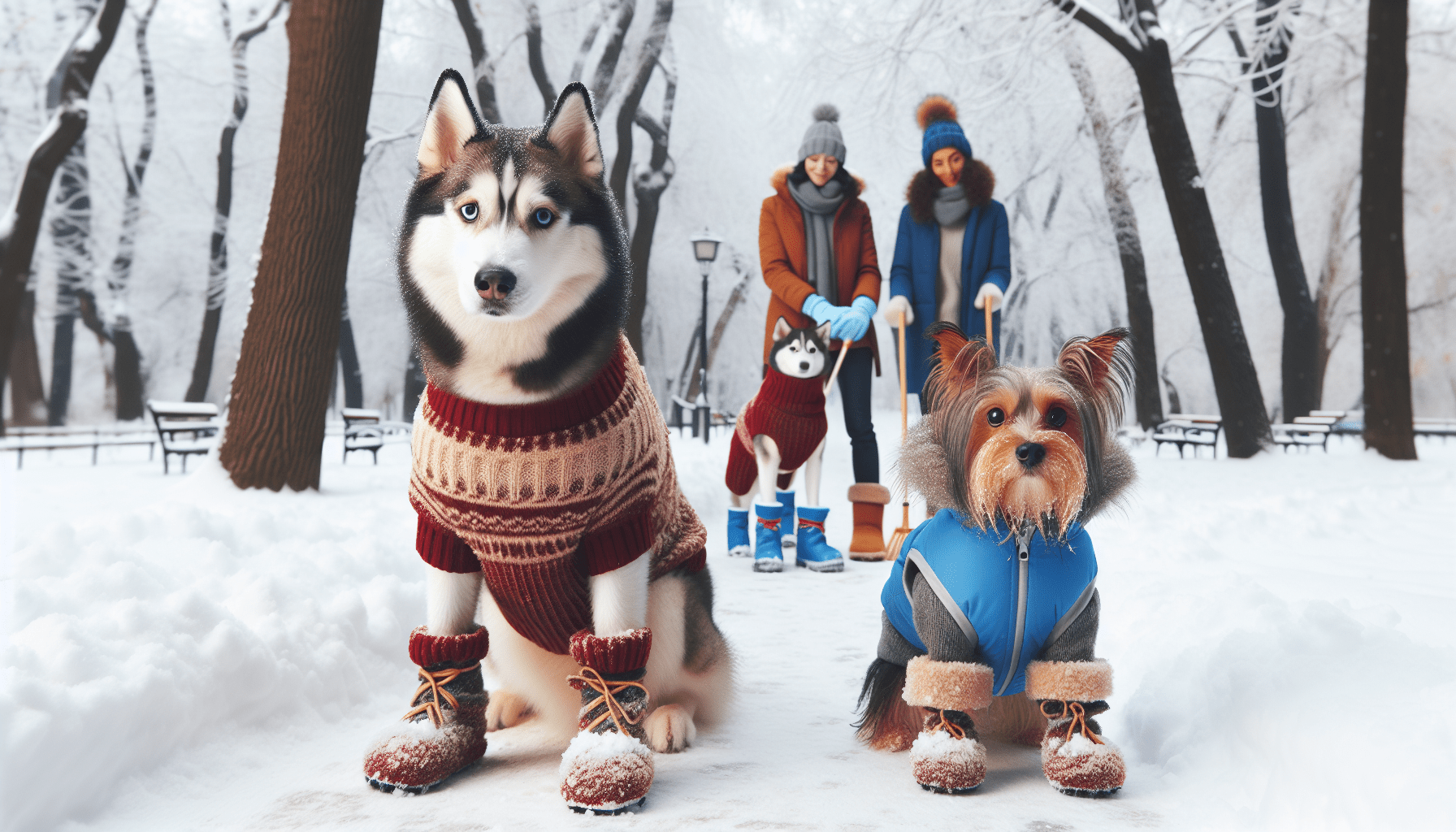As the winter season approaches, it’s important to take extra precautions to keep your furry friend safe and comfortable. In this article, you will discover some essential tips on how to keep your dog safe in winter. From protecting their paws from icy surfaces to ensuring they stay warm during outdoor adventures, these simple yet effective strategies will help you navigate the colder months with ease. So, let’s dive right in and make sure your beloved companion stays happy and healthy all winter long!

1. Indoor Safety Measures
Limit outdoor exposure
During the winter months, it’s important to limit your dog’s exposure to the cold weather. Prolonged exposure to freezing temperatures can be dangerous and lead to hypothermia or frostbite. You can accomplish this by keeping outdoor walks shorter and encouraging indoor activities instead.
Create a cozy space indoors
To ensure your dog is comfortable and warm inside, create a cozy space for them. Provide a warm and comfortable bed with extra padding, blankets, or even a heated mat. This designated space will give your dog a sense of security and a warm place to curl up during the winter chill.
Use space heaters cautiously
While space heaters can provide warmth during the colder months, it’s essential to use them cautiously around your dog. Keep them out of your dog’s reach and make sure your dog cannot accidentally knock them over, potentially causing a fire hazard. Always supervise your dog around space heaters and consider using pet-friendly heating options instead.
Keep harmful substances out of reach
During the winter, many households use antifreeze and other chemicals that can be harmful to dogs if ingested. Keep these substances out of your dog’s reach and be cautious of any spills or leaks. It’s also important to use pet-safe ice melt products on your property to avoid any potential harm to your furry friend.
2. Outdoor Winter Gear
Invest in a winter coat
If you have a short-haired or small breed dog, investing in a winter coat can provide them with additional insulation and protection against the cold. Look for a coat that covers their entire back and chest, making sure it’s made of a waterproof and insulated material.
Get booties for protection
Protect your dog’s paws from the harsh winter elements by getting them a pair of booties. Booties can prevent their paws from coming into contact with ice, salt, and other chemicals that may be present on winter sidewalks. They can also provide additional traction, reducing the risk of slips and falls.
Use a reflective collar or vest
With shorter daylight hours during winter, it’s important to make sure your dog is visible during walks. Consider using a reflective collar or vest that will make them more easily seen by motorists. This added visibility can help prevent accidents and keep your dog safe.
Consider a doggy snood or hat
For dogs with thin fur around the neck and ears, a doggy snood or hat can provide extra warmth and protection against the cold. These accessories can help prevent frostbite and keep your dog’s sensitive areas covered during cold weather outings.
3. Exercise Precautions
Schedule shorter walks
When temperatures drop, it’s crucial to schedule shorter walks to minimize the amount of time your dog is exposed to the cold. Even though your dog may still need exercise, it’s important to prioritize their safety and well-being in extreme weather conditions.
Choose warmer times of the day
Plan your walks during the warmer parts of the day, such as late morning or early afternoon when the sun is out and temperatures are relatively higher. This will help ensure your dog stays comfortable and prevents them from being exposed to freezing temperatures for an extended period.
Avoid icy or slippery surfaces
When walking your dog, steer clear of icy or slippery surfaces. These can cause your dog to slip and potentially injure themselves. Opt for paths that have been cleared of snow and ice, or consider using booties with good traction to prevent slips.
Watch out for signs of hypothermia
Even with precautionary measures, it’s important to be mindful of signs of hypothermia in your dog. Symptoms can include shivering, weak pulse, lethargy, and pale gums. If you notice any of these signs, bring your dog indoors immediately, dry them off, and wrap them in warm blankets. Contact your veterinarian for further guidance and assistance.
4. Paw and Skin Care
Wipe paws after walks
After returning from a winter walk, make sure to wipe your dog’s paws thoroughly. This will remove any snow, ice, or chemicals that may have accumulated on their paws. Pay special attention to the areas between their toes.
Apply paw balm for protection
The cold weather and salt used on roads and sidewalks can be harsh on your dog’s paw pads. To keep their paw pads healthy and protected, consider applying a paw balm or wax before heading outside. This creates a barrier between their paws and the cold ground, preventing dryness and cracking.
Check for dry or cracked skin
Regularly check your dog’s skin, particularly on their paws, elbows, and other areas exposed to the cold. Look for any signs of dryness, cracking, or irritation. If you notice any issues, consult with your veterinarian who can recommend appropriate skincare products or remedies.
Use a moisturizing shampoo
During winter, the dry indoor environments can also affect your dog’s skin. To prevent dryness and itching, consider using a moisturizing shampoo specifically formulated for dogs. This will help maintain their skin’s natural moisture balance and alleviate any discomfort they may be experiencing.

5. Hydration and Nutrition
Ensure access to fresh water
Even in cold weather, it’s essential to provide your dog with access to fresh water at all times. Hydration is crucial for overall health, and cold weather can increase the risk of dehydration. Ensure their water bowl is not frozen and check it frequently to ensure it remains unfrozen.
Increase food intake when necessary
In colder temperatures, dogs may burn more calories to keep warm. Monitor your dog’s weight and body condition, and consult with your veterinarian to determine if an increase in their food intake is necessary. Providing them with adequate nutrition will help support their energy levels and maintain a healthy weight during winter.
Consider warming the food
If your dog prefers warm meals, consider heating their food slightly before serving it to them. Warming their food can make it more appealing during colder weather and may encourage them to eat. However, be cautious not to overheat the food or make it too hot for your dog’s consumption.
Include omega-3 fatty acids in the diet
Omega-3 fatty acids, such as those found in fish oil, can provide numerous benefits for your dog’s overall health, including promoting healthy skin and coat during colder months. Consult with your veterinarian to determine a suitable dosage of omega-3 supplements or to discuss incorporating foods rich in these fatty acids into your dog’s diet.
6. Winter Car Safety
Never leave your dog alone in the car
Extreme temperatures can be just as dangerous inside a car as they are outside. Never leave your dog unattended in a car during winter, as the cold can quickly lead to hypothermia. If you need to run errands, leave your furry friend at home where they are safe and warm.
Keep them restrained with a seat belt or crate
When traveling with your dog in the car during winter, make sure they are properly restrained. This can be achieved by using a seat belt harness or placing them in a secure crate. This prevents your dog from becoming a distraction to the driver and also provides a safer environment in case of sudden stops or accidents.
Provide blankets for warmth
If your dog will be sitting in the car during winter, provide them with blankets to keep warm. The blankets should be thick enough to provide insulation and protect your dog from the cold. Ensure they are positioned in a way that allows your dog to snuggle up and stay cozy throughout the journey.
Make sure the car is well-ventilated
While it’s important to keep your dog warm in the car, it’s equally crucial to ensure proper ventilation. Crack a window slightly to allow fresh air to circulate and prevent condensation from building up inside the vehicle. This will help maintain a comfortable and safe environment for your furry companion.
7. Fireplaces and Heaters
Supervise your dog around open flames
If you have a fireplace or use a space heater, it’s essential to supervise your dog around these open flames. Make sure they do not get too close to avoid the risk of burns. Additionally, be cautious of any loose clothing or bedding that your dog may have around these heat sources, as they can easily catch fire.
Use safety gates or barriers
To prevent your dog from getting too close to fireplaces or heaters, consider using safety gates or barriers to restrict their access. This will ensure their safety and provide you with peace of mind, especially when you cannot directly supervise them.
Choose pet-friendly heating options
When selecting heating options for your home, consider pet-friendly alternatives. Electric radiators or wall-mounted heaters that are out of your dog’s reach can provide warmth without posing a direct risk to them. Avoid using space heaters with exposed heating elements or open flames.
Keep an eye on the temperature
While heating your home during winter, keep an eye on the temperature to ensure it remains comfortable for your dog. Dogs have a higher body temperature than humans, so what feels warm to you may be too hot for them. Adjust the thermostat accordingly to maintain a comfortable and safe environment.
8. Antifreeze and Chemicals
Be cautious with antifreeze
Antifreeze, which contains ethylene glycol, is extremely toxic to dogs. Even a small amount can be fatal if ingested. Be cautious when using antifreeze and ensure all containers are securely closed and stored out of your dog’s reach. If you suspect your dog has ingested antifreeze, seek emergency veterinary care immediately.
Clean up spills immediately
If you accidentally spill antifreeze or any other chemicals on the ground, clean it up immediately. Dogs are attracted to the sweet taste of antifreeze, and even licked traces of it can be harmful. Use absorbent materials such as cat litter or sand to soak up the spill, then dispose of it safely.
Use pet-safe ice melt products
Ice melt products used on sidewalks and driveways can also be harmful to dogs. Look for pet-safe alternatives that are free of harmful chemicals such as calcium magnesium acetate or sand. These options will minimize the risk of skin irritation or ingestion if your dog happens to lick their paws after contact with the product.
Avoid other toxic substances
Be aware of other toxic substances commonly used during winter, such as rodenticides or de-icing agents. Keep these products securely stored away from your dog’s reach and avoid using them in areas where your dog has access. Always read labels carefully and follow instructions to prevent accidental exposure.
9. Extra Precautions for Senior Dogs
Provide extra warmth and comfort
Senior dogs are more vulnerable to the cold and may require additional warmth and comfort. Consider providing them with extra blankets or investing in a heated bed to keep them cozy. Older dogs may also benefit from wearing a sweater or jacket during winter outings.
Consider joint supplements if needed
Winter weather can be especially tough on senior dogs with arthritis or joint issues. Consult with your veterinarian to determine if your dog would benefit from joint supplements or other therapies to alleviate any discomfort or stiffness they may experience during the colder months.
Monitor exercise intensity
While exercise is essential for senior dogs, it’s important to monitor their activity levels, especially in winter. Senior dogs may have more difficulty navigating icy or slippery surfaces and can easily overexert themselves. Adjust the intensity and duration of their exercise accordingly to prevent any unnecessary strain or injury.
Be mindful of arthritis symptoms
Cold weather can exacerbate arthritis symptoms in senior dogs. Keep an eye out for signs of increased stiffness, reluctance to move, or difficulty in getting up. If you notice any of these symptoms, consult with your veterinarian for a comprehensive arthritis management plan to keep your senior dog comfortable and mobile.
10. Winter Grooming Tips
Keep the fur longer for insulation
During winter, consider leaving your dog’s fur length slightly longer for added insulation. However, be mindful of matting or excessive coat growth, as this can trap moisture and lead to skin issues. Regular brushing to keep the coat clean and well-maintained is still necessary.
Regularly brush to prevent matting
To prevent mats from forming in your dog’s fur during winter, establish a regular brushing routine. Brushing helps remove loose hair, dirt, and tangles, while also stimulating the skin and improving circulation. Use a brush suitable for your dog’s coat type and be gentle to avoid any discomfort.
Trim hair around paws for cleanliness
During winter walks, your dog’s paws can accumulate ice balls or debris between the paw pads. Trim the hair around their paws to keep them clean and prevent these irritants from causing discomfort or potential injury. Be careful not to trim too close to the skin to avoid accidental cuts.
Avoid excessive bathing
While it’s important to keep your dog clean during winter, avoid excessive bathing, as it can strip their coat of natural oils and further contribute to dry skin. Instead, opt for dry shampooing or spot cleaning when necessary. If your dog requires a full bath, use a moisturizing shampoo and ensure their coat is thoroughly dried afterward.
By following these indoor and outdoor safety measures, you can keep your furry friend safe and comfortable throughout the winter season. Remember to prioritize their well-being and pay attention to any signs of discomfort, ensuring a happy and healthy winter for your beloved dog.

